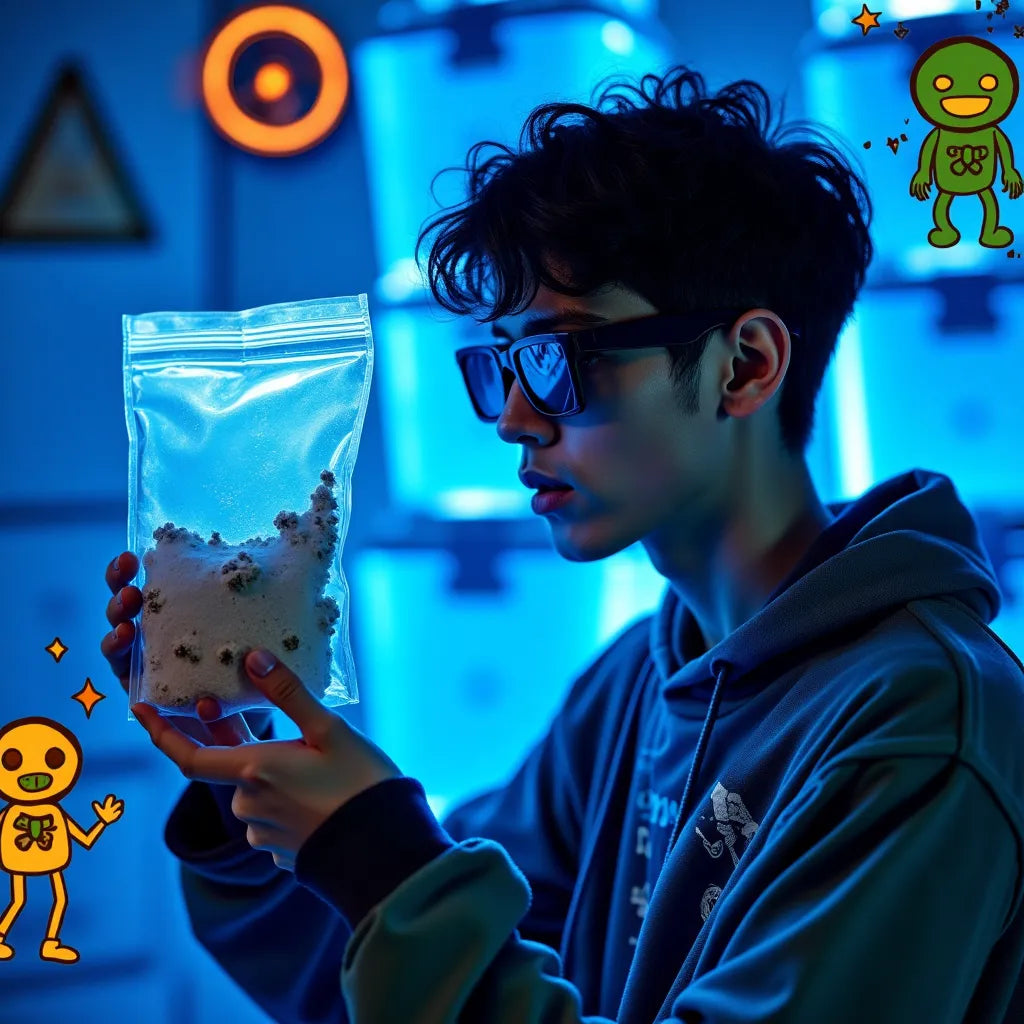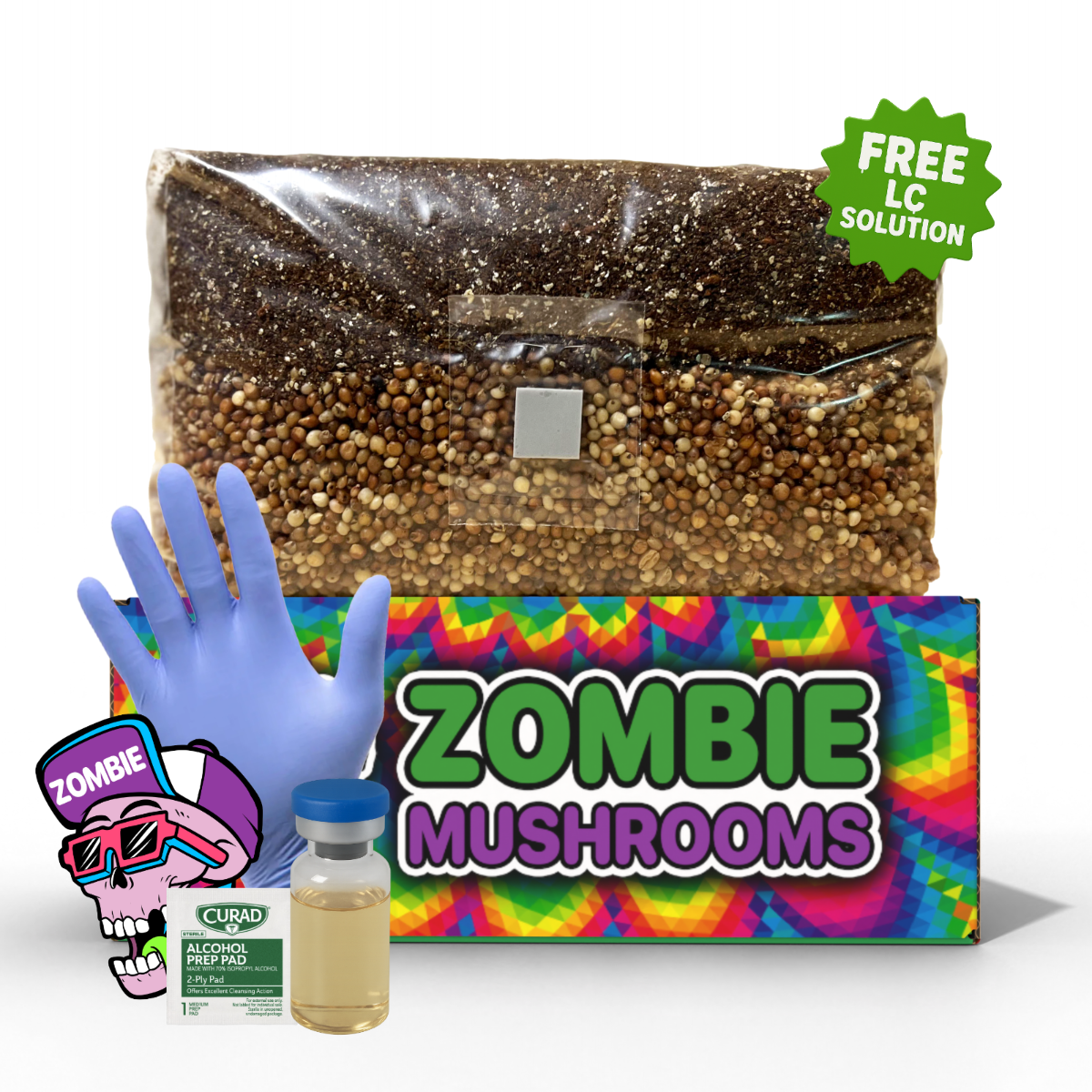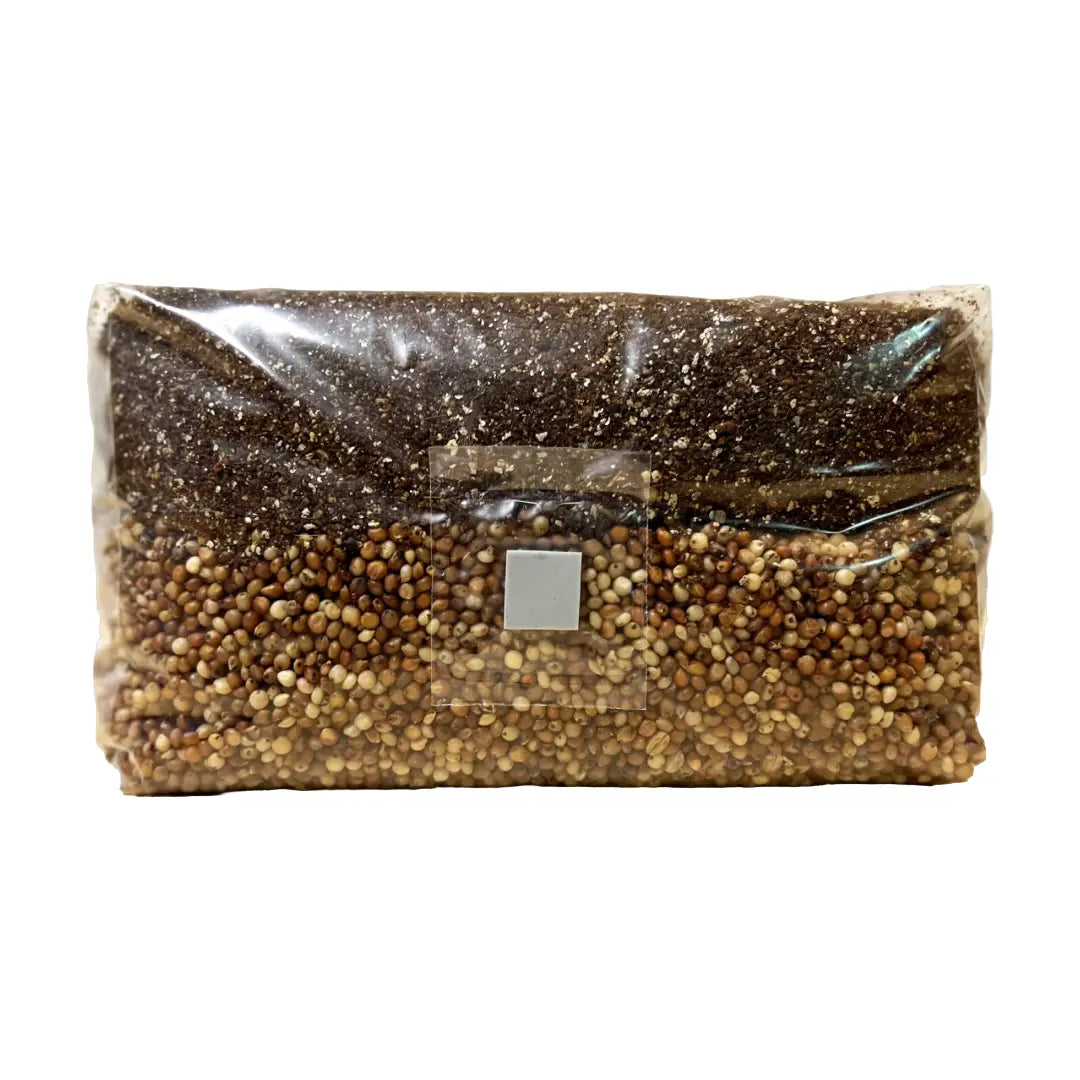⬇️ Prefer to listen instead? ⬇️

- ⚠️ Green mold (Trichoderma harzianum) can destroy mushroom spawn within 48–72 hours.
- 🧪 Once airborne, Trichoderma spores can contaminate entire grow operations swiftly.
- 💨 Poor airflow and high humidity significantly increase contamination risks.
- 🔬 Surgical removal of green mold has low success—complete disposal is often safer.
- 🧼 Sterile techniques and reliable supplies drastically reduce contamination incidents.
You open your mushroom grow bag expecting fluffy, white mycelium—only to find a dreaded green patch instead. Green mold, especially Trichoderma harzianum, is one of the most common and destructive contaminants in mushroom cultivation. It can derail a grow within 48–72 hours. This guide will help you identify early signs, take quick action, and adopt practices that prevent recurrence. If mold problems persist, using a mushroom grow bag with high-quality filter patches and strict hygiene drastically improves your odds of success.
Understanding the Threat: What Is Green Mold?
Green mold in mushroom grow bags is most often caused by a type called Trichoderma harzianum. This tough, fast-spreading fungus likes the same food as mushroom mycelium—organic, nutrient-rich substrates. But unlike good organisms, Trichoderma feeds on others. It directly attacks mushroom mycelium. It puts out chemicals that break down cell walls and kill the fungal tissue. So, it takes over the food and space.
Trichoderma is not always bad. Farmers sometimes use it to fight crop diseases because it's good at controlling other things. However, when growing mushrooms at home, it becomes a problem. Once spores get into your mushroom grow bag, they grow fast where it's warm, wet, and has lots of food. It grows incredibly fast. In just 48 to 72 hours, green mold can take over your whole spawn block (Stamets, 2000).
An outbreak usually spreads past just one bag. And then, spores float through the air onto nearby bags, tools, or even your hands and clothes. This lets green mold come back later, even if you try hard to stop it. That's why Trichoderma is one of the biggest problems for growing mushrooms indoors.
Spot Green Mold Early Before It Spreads
The sooner you spot green mold, the better your chances are of saving the surrounding area. Trichoderma looks a certain way, but spotting it early means watching closely. You also need to know what healthy mycelium looks like.
Here's what to look for to know if green mold is there:
-
Color shifts: Starts from white or off-white mycelium, then patches begin turning olive green, emerald, or darker as spores form.
-
Texture: Powdery, velvety, or fuzzy growth that seems raised above the substrate surface—not tight or rope-like.
-
Pattern of spread: Begins in localized spots, often at seams, openings, or areas that stay moist, then spreads rapidly.
-
Smell & moisture clues: Sour, sharp, or ammonia-like odor; wet or waterlogged substrate indicates excess moisture that favors Trichoderma.
-
Compare to healthy mycelium: White, ropey or thread-like, clean earthy smell. Fluffy whiteness alone isn’t mold—look for color change and scent.
On the other hand, healthy mycelium is white and smells clean. It often makes rope-like strands. This shows it's growing well. Mycelium that looks cottony or fluffy might mean it's too wet. But it doesn't always mean mold is there unless it changes color or smells bad too.
Clear grow bags let you see how things are growing inside without opening them. This makes it easier to spot problems early.

Common Sources of Contamination
Green mold often happens because of poor clean methods. Also, it happens when spores get in from outside. Even one mistake in your steps can let Trichoderma win. Here are the main ways it gets in:
- Incomplete Substrate Sterilization: This is a main cause. If grain spawn or bulk substrate is not cleaned right under high pressure (15 PSI for 90+ minutes), some mold spores can live. They will start growing after you put the culture in.
- Non-sterile or Weak Cultures: Using spore syringes or older cultures not checked on agar can bring in unknown problems, like mold, bacteria, or yeast.
- Dirty Inoculation Spaces: If the space is messy or not filtered when you fill bags or put the culture in, your stuff is exposed to spores and dirt in the air.
- Contaminated Tools, Gloves, or Clothing: Problems often happen using unclean tools. Or it happens from sleeves of a hoodie that touched an old grow. Gloves will not help if you touch your dirty phone while working.
- Old or Damaged Grow Bags: Using bags again or using bags with bad seals can let spores get into your clean substrate.
- High Humidity with Poor Ventilation: Mushrooms like moisture. But too much wetness combined with still air makes the best place for mold spores to grow.
- Air Currents From HVAC or Fans: Air moving from heaters, AC, or fans that isn't filtered right can spread Trichoderma spores around the room. It can even spread them between different grows happening at the same time.
Staying very clean and following strict clean rules are steps you cannot skip if you want to stop mushroom contamination.
Early Detection and Its Importance
Checking your bags often should be part of your daily habit while the mycelium grows and the mushrooms form. Green mold can spread very fast across your bags in just days. So, spotting it early is very important. Here's how to have a better chance:
- Transparent Grow Bags: These let you see growth from all sides without opening the bag. They are great for watching the mycelium grow and seeing strange things.
- Proper Lighting: Check bags in bright, natural light if you can. Grow lights or LEDs can sometimes make colors look different.
- Magnifying Glass: If the grow is important, using a lens sometimes can help you spot tiny mold spots before they turn green and make spores.
If you catch the green color early—before it makes spores—it might just stay in one small spot. You might be able to deal with it. The main goal is to find an infected bag and get rid of it before it makes spores that float in the air and spread problems.
How to React Fast When Green Mold Shows Up
When you see green mold, think of it as a danger to the rest of your grow space. Do these steps in order:
-
Isolate the bag immediately: Remove it from your grow space to prevent spores spreading. Keep it sealed or bagged.
-
Dispose or attempt localized removal: If the green mold is only a tiny patch and remote from mycelium, carefully remove the affected portion with sterile tools and seal the cut. But often the safest choice is full disposal of the bag.
-
Disinfect everything: Clean nearby surfaces, tools, and your hands with 70% isopropyl alcohol or a bleach solution (1 part bleach to 10 parts water). Let dwell time for disinfectants be at least one minute.
-
Check all other bags/areas: Mold spores are airborne; inspect adjacent bags, cloths, and gloves for signs of contamination.
-
Improve growing conditions: Once you’ve removed the threat, adjust humidity, airflow, seal integrity of bags, and sterilization steps to avoid repeat incidents.
Time is important here. The longer a bag with mold stays in your grow space, the more likely spores are to land elsewhere and start growing.
Can Contaminated Bags Be Saved?
In some rare cases, yes. But it is usually not worth the risk. Growers with lots of practice sometimes try to cut out mold spots. They do this if the spots are small, only in one place, and far from where the mycelium is growing.
If you try to save a bag:
- Use clean tools, like a scalpel or a blade heated clean.
- Cut at least two inches beyond the area that looks green. Trichoderma can be there even if you can't see the color.
- Right away, seal and clean the cut area with rubbing alcohol before closing the bag again.
But this rarely works for long. Spores are hard to get rid of completely. Also, the mycelium nearby might already be weak or dying even if it looks fine. Most people who grow mushrooms as a hobby or in small amounts find it safer to throw the bag away and start over.
Learn from what happened. Figure out how the mold got in. Then, change your steps for putting in the culture or making things clean for your next try.

Preventive Measures: Creating a Mold-Unfriendly Environment
The best way to fight green mold is to make sure your grow area is a bad place for it to live. Here are important steps to help your space fight off mold:
- Sterilization: Pressure cook substrates at 15 PSI for at least 90–120 minutes. The time depends on how much you are cooking.
- Use a Flowhood or Still Air Box (SAB): Put in cultures in separate, controlled spaces. Flow hoods are best for labs. SABs work well and do not cost much for home growers.
- Limit Exposure Time: Once substrate or grain jars are open to the air, work quickly. The less time you touch open stuff, the less risk you have.
- Disinfect Regularly: Clean your tools often. But also clean the area itself—shelves, tubs, tables where you put cultures, gloves, and anything else in your grow area.
- Monitor Humidity & CO2: Use tools to make sure the air stays below 95% wetness. Also make sure proper fresh air gets in through HEPA filters.
- Don’t Crowd Your Bags: Putting too many bags close together creates small wet spots with still air that molds love.
Think of your grow area like a super clean lab room. When you grow mushrooms, that's pretty much what it should be.

Advanced Strategies: Products and Approaches
More experienced growers can add certain things. These are additives and biological agents that make it harder for mold to grow.
- Hydrated Lime in Casing: Makes the substrate or casing layer less acidic. This can stop Trichoderma spores from starting to grow.
- Beneficial Microbes (e.g., Bacillus subtilis): Some sprays that kill mold have bacteria in them. These bacteria eat mold spores or take up space so mold cannot get started.
- Hydrogen Peroxide Spray (3%): Sprayed lightly between grows, it can kill mold spores without leaving harmful stuff behind.
- Compost Additives: Some special mixes have things from plants or safe oils that fight mold. Always check that they are safe for mushrooms you plan to eat.
- UV Sanitizers or HEPA Filter Upgrades: You do not have to use these, but they help if you use grow tents or chambers a lot.
Also keep in mind, many of these things are best used between grows or before mushrooms start forming. They must also be safe for mushrooms you plan to eat.

The Importance of Using Quality Supplies
How good your starting stuff is can really change how often you get mold.
- Use Liquid Cultures (LCs) from Trusted Labs: Spores might carry mold spores you cannot see. LCs are cleaner if they have been tested and checked.
- Run Agar Tests First: Before putting your culture into your good substrate, put some on a dish with agar first. Watch it grow for 5–7 days.
- Buy Professional Mushroom Grow Bags: These have good seals and filter patches. They let air move in and out but stop bad stuff from getting in.
Zombie Mushrooms sells top mushroom grow bags, substrate kits that are already clean, and cultures tested in a lab. These are great for people growing as a hobby or on weekends who want good quality without needing a lab.
Long-Term Best Practices for Mold-Free Growing
To make your space always fight off green mold, get into good habits:
- Standard Operating Procedures (SOPs): Write a checklist for every time you work on your grow. Include steps for making things clean, handling, and checking bags.
- Track Inoculation Dates: Use labels with dates to see how fast the mycelium is growing. This helps you find bags that are growing slow or look strange sooner.
- Cycle Cleaning: Clean monotubs, shelves, grow tents, and tools well between every grow cycle. Do this even if no mold or problems happened.
- Backup Cultures: Keep clean cultures or agar plates in the fridge. Think of them as ways to start over if your main culture gets bad.
Growing mushrooms is half art, half precision science. Keep a detailed record of your grows. Write down when you get mold, what you changed, and what you saw about the air. This will help you get better over time.

Frequently Asked Questions
-
Is green mold (Trichoderma) always fatal to a grow bag?
Not always—if caught very early, a small localized spot might be removable. But often, the mold has already spread microscopically, so disposal is safer. -
What conditions encourage green mold in grow bags?
Excess moisture, poor airflow or ventilation, weak sterilization of substrate, contaminated tools or spawn, and high ambient spore load are common causes. Penn State Extension+2North Spore+2 -
Can I prevent green mold by using better tools or different bags?
Yes—using bags with sturdy filter patches, self-healing ports, ensuring tight seals, and maintaining sterilized equipment all help reduce contamination risk. -
What moisture level is too much for a grow bag?
If substrate is soggy, water pooling, or condensation constantly dripping, moisture is too high. Target moisture where substrate is moist but not saturated—air pockets should remain. -
Do monotubs help with mold issues?
Monotubs provide more space and often better control over airflow and humidity. If your grow space is small or condensation is a problem, switching to monotub setups may help reduce the chance of green mold outbreaks.
Grow Smart, Stay Clean
Everyone who grows mushrooms deals with green mold sometimes. But it doesn't have to ruin your hobby or business. Learn about it, make your methods better, and buy good stuff. If you do this, you can greatly cut down on mold problems. Stopping it before it starts is always easier than fixing it later. Start good habits now. Your later grows will be better because of it.
Zombie Mushrooms sells kits made to help you grow clean without mold. Download our free sterile workflow checklist and get started growing smarter, not harder.
Citations
- Stamets, P. (2000). Growing Gourmet and Medicinal Mushrooms. Berkeley: Ten Speed Press.
- Rinker, D.L. (1995). Handling Contaminants in Mushroom Production. Proceedings of the National Mushroom Industry Conference.
- USDA Agricultural Research Service Bulletin. (2012). Mushroom Cultivation and Contamination Prevention.



